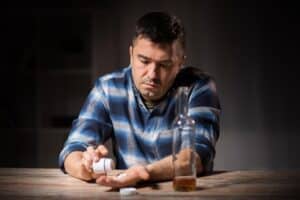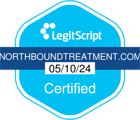Heroin detox is intense and can feel overwhelming, but it’s also temporary and the foundation needed to jumpstart your path to long-term recovery. A medically managed detox program is the best route of care to end dependency and provide the support you need during this process. Each person will have their own unique experience when it comes to detox, since different factors contribute to the severity of opiate addiction, such as your overall state of health. In general, the typical heroin detox program lasts for a seven-to-ten day period.
The first few days are when withdrawal symptoms are the most intense and when cravings are particularly strong. Since your body is used to functioning with heroin in the system, refraining from use causes it to react in painful and uncomfortable ways. The range of withdrawal symptoms you can expect to experience include:
- Nausea
- Vomiting
- Diarrhea
- Intense muscle aches
- Excessive sweating
- Shaking
- Nervousness
- Irritability
- Anxiety
- Depression
- Tremors
- Hallucinations
- Seizures
These symptoms of heroin are often unpredictable and begin within a few hours of your last dosage. There’s no way to forecast how long they’ll last for certain or the frequency or severity at which you’ll experience them.
Attempting to detox on your own on any level is difficult as you try to combat these symptoms and take care of yourself at the same time. It’s important to consider the benefits of being part of a facility-monitored heroin detox program, which provides assistance day and night, whenever you need it. If there’s a period of time where you require medical assistance, like with seizures, you won’t have the immediate medical attention you need if you’re by yourself.
As the severity and frequency of heroin detox symptoms begins to decline, it’s important to stay as hydrated and nourished as possible to maintain a healthy immune system. When you are near the final days of detox, you may still experience a few symptoms, but with far less intensity. These reactions are your body’s way of ridding the drug from your system and recalibrating itself to a stable physical state.
Dealing With The Possibility of Relapse
Possible scenarios of what to expect during heroin detox include relapse or co-occurring health conditions or mental disorders. Relapse commonly occurs during detox, especially when you have to manage your withdrawal symptoms alone. Without the medical and emotional support available through a treatment facility, it can easily lead to a dangerous cycle of addiction and relapse. Also, when you detox at home, there is still the same temptation that may be difficult to ignore when you’re in the beginning phases of care.
If relapse does occur, the timeline starts over. This isn’t considered a failure, but rather an opportunity to reset and begin again. Going through the process in the safety and comfort of a secure environment provides the kind of atmosphere most conducive to your well-being and healing success.
Another possible scenario that may arise is the diagnosis of another health condition besides your addiction. This may affect or delay the timeline, depending on the strain it causes on your body. For example, a weak immune system may make the symptoms feel more intense or take longer to subside. Additionally, a co-occuring mental disorder like depression requires treatment beyond the initial detox stage. A team of certified medical practitioners will be dedicated to your treatment plan and work with you to determine the best route of care.
This includes a combination of non-opioid medication to reduce cravings and minimize heroin detox symptoms, in addition to behavior therapy. Methadone and buprenorphine are two medications which may be administered and monitored by a medically-trained professional. Behavioral therapies include methods such as cognitive-behavioral therapy and contingency management.
The first aims to modify the person’s drug-use behaviors by working to manage expectations, triggers, and stress. The latter provides motivational incentives and reinforces positive behavior as a way to promote healing. The specific techniques and therapies used to treat your drug addiction will be based on your current health status and long-term goals.
Experiencing The Emotional Effects of Heroin Withdrawal
PAWS or post-acute withdrawal symptoms are reactions that continue after the initial drug detox timeline. There is a high likelihood of these occurring in people who have long histories with opioid substance abuse. PAWS involve the emotional effects of heroin withdrawal, which can be just as painful as the physical effects, if not moreso. They affect your memory, appetite, and mood, resulting in feelings of irritability, anger, and depression. These, too, range in severity and duration and can fluctuate from day-to-day or week-to-week.
PAWS are the result of your brain attempting to adjust to no longer receiving its signal of pain relief and pleasure from heroin. The brain must eventually resume its natural production of endorphins and dopamine to experience these feelings again without the crutch of a drug. It can take several months for the brain to replenish these chemicals, which determines how long and how intensely you’ll feel the pain until then.
Any significant change in life brings emotional stress, which is another reason why it’s not recommended to go through the detoxification phase alone. Turn to those who are ready and capable of assisting you through all the stages of symptoms and make it as manageable for you as possible. Even if you have a reliable support system at home, the environment may not be what you need at the moment as it can detract from your progress and efforts.
Signs of Heroin Addiction: How to Tell When to Seek Treatment
There are visible signs of heroin addiction that you’ll experience, which will be hard to hide. Heroin is a disease that occurs when you are unable to stop using the drug. This will affect your mood and appearance. It affects your decision-making and ability to control your behavior. As a result, heroin addiction may lead to legal, work, and relationship problems, on top of the physical withdrawal symptoms that occur.
If drug abuse has begun to affect other areas of your life where you fail to meet your usual responsibilities or are incapable of maintaining your personal appearance and wellness, these are signs heroin addiction has taken control over your life. Overdose is another extreme signifier of heroin abuse. The need to increase doses with greater frequency can lead to overdose. When this occurs, your breathing slows down or stops altogether. It limits the amount of oxygen to the brain and can cause a stroke, brain damage, coma, and/or death.
The constancy of which you use heroin, regardless if it’s prescribed pain medication is indicative of your dependence on the drug. In fact, prescribed opioids have been the trigger for many to transition to heroin use. The addiction level is comparable and comes with the same side effects, withdrawal symptoms, and dangers of any other form.
Experience Detox Safely Through an Addiction Treatment Facility
Heroin detox is the first step of at least a year-long treatment process. After the initial phase of going through withdrawal systems and allowing your mind and body to resume to a balanced state, the next phase of care is crucial to continue with your long-term recovery. Residential rehab is the next recommended phase, which includes a 90-day stay at the treatment center. It provides a safe, comfortable place with a set structure to observe and guide your daily care.
Your dedicated team of therapists will incorporate a wide range of therapies that address underlying factors of your addiction to treat it at its core. Northbound residential treatment programs are gender-responsive. Data shows when men and women participate in gender-specific addiction treatment programs, there’s a tendency to remain in treatment longer and experience better outcomes than those who don’t.
Every part of recovery is designed to help you thrive in a peaceful environment and regulated structure. The core of heroin addiction treatment includes individual and group therapy, physical exercise, meditation and yoga, support groups, outdoor experiential activities, and free time. Building a steady routine where your mind and body are kept busy in healthy ways keeps you moving toward your goals.
Following residential treatment is intensive outbound care. There are several treatment program options available to meet you where you are in life and provide guidance and accountability to help you solidify your recovery lifestyle. This level of care is designed for those who have established a secure and sober living environment and are ready to continue recovery substance-free without residential treatment.
Program work occurs weekly and is based on your schedule and determined by your real-life needs. The same principles of residential care are applied with the added 12-Step engagement and opportunity to participate in a signature service to plan for your next step of life. This may involve enrollment in school, job placement, or repairing relationships damaged by drug addiction.
Going through the first phase of heroin detox is the important first step to build upon. The goal is to reach one year of continuous sobriety through a full continuum of care: detoxification, residential rehab, intensive outpatient treatment, and addiction support services. During this time, you’ll gain confidence and independence in your recovery to build upon once treatment is complete. After the treatment program is over, you’ll still have support and resources available to you to help you maintain sober living in a way that’s sustainable for you.
Sources:
- National Institute on Drug Abuse. “Heroin DrugFacts.” National Institute on Drug Abuse, 16 June 2020, www.drugabuse.gov/publications/drugfacts/heroin
- Mager, Dan. “Detoxing After Detox: The Perils of Post-Acute Withdrawal.” Psychology Today, Sussex Publishers, 26 May 2015, www.psychologytoday.com/us/blog/some-assembly-required/201505/detoxing-after-detox-the-perils-post-acute-withdrawal











